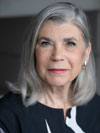 | |
| Fabiola Gianotti - huntress of the god particle |
Described as the defining face of the hunt for the Higgs Boson, because of her lucid performance as the spokeswoman and co-ordinator of the Atlas experiment that made the breakthrough in detecting the so-called God particle in the summer of 2012, Milan-born Gianotti has become a role model for many young would-be scientists, especially female ones.
I was visiting CERN as one of a small group from the Friends of Imperial College invited to see the CMS (Compact Muon Solenoid) experiment masterminded by Imperial's Professor Tajinder Virdee. Click here for more about the trip. The CMS is, with the Atlas experiment, a key part in the search for the Higgs Boson. It is the point on the 27km Large Hadron Collider running deep in the ground around Geneva where the cataclysmic collisions take place, replicating the big bang of the birth of the universe.
Before visiting the CMS experiment, we are given an introductory presentation. Amongst the facts and figures about this extraordinary collaborative venture, I spot that of the 6,000 or so scientists at CERN, there are currently twice the number of Italian scientists (1455) than from the UK (728). The presentation is being given by Dr Mario Campanelli, so who better to ask why physics is such an attractive subject for his fellow countrymen - and women?
He ponders for a few moments. "It is a cultural thing, I think," he says. "In Northern Europe, it is regarded as a technical or engineering discipline and it is people with scientifically inclined minds that tend to study it. In Italy and much of southern Europe, we see physics as a philosophical or even metaphysical discipline."
Dr Campanelli then reels off the names of women colleagues who are leaders in their field including Lisa Randall a theoretical physicist and expert on particle physics and cosmology at Harvard; Dr Ilaria Segoni, particle physicist, and - hooray - Tara Shears, Professor of Physics at Liverpool University. She began working at CERN on the OPAL experiment, measuring the lifetime of the tantalisingly named beauty quarks, before joining the team at CMS and seeking answers to why there's so little antimatter in the universe.
 |
| Visible women at CERN |
 |
| Long way down - and up |
But let's return to that philosophical v scientific debate in relation to physics. Fabiola Gianotti's schooling was focused almost exclusively on the classical humanities. It is a cliche she says, that scientists are only interested in data and hard facts. An accomplished pianist, she sees many links between physics and mathematics, art, architecture and music. Lisa Randall, the Harvard professor, has written an opera.
This should not be a surprise. From Leonardo da Vinci through to Professor Sir Robert Winston (musician, film maker and writer as well as world famous medical man) there have been many examples of Renaissance man. Now is the time to encourage and nurture more Renaissance women, with persuasive arguments demonstrating the artistry of mathematics, the philosophy of physics and the humanity of engineering.
 |
| Sandi and Rod go underground |




1 comment:
Great blog - and a real insight into an alternative view of physics.
Post a Comment